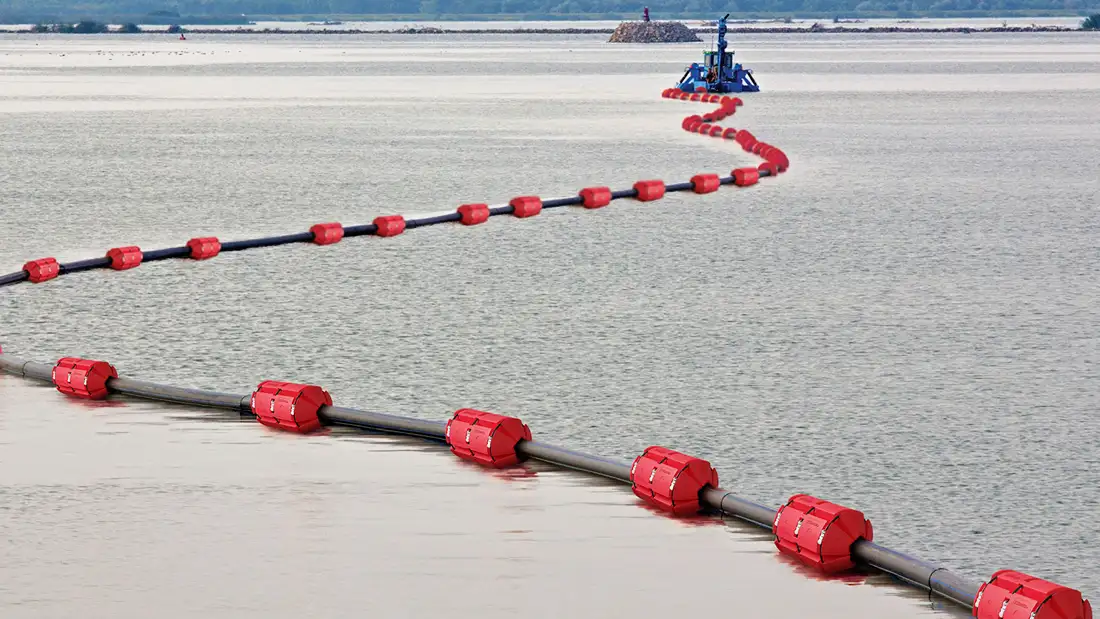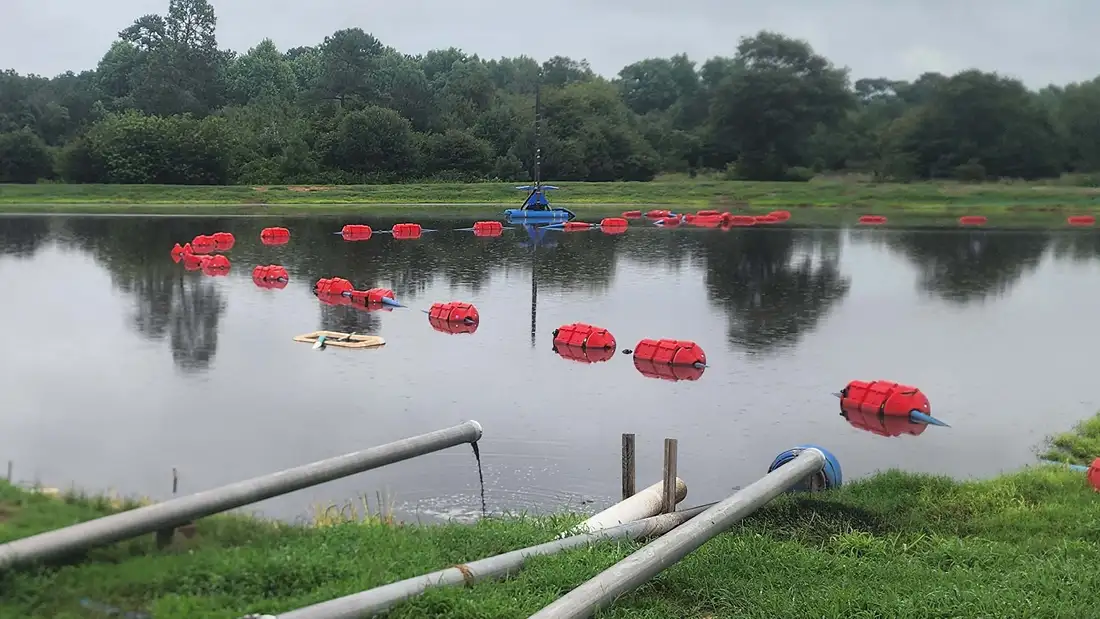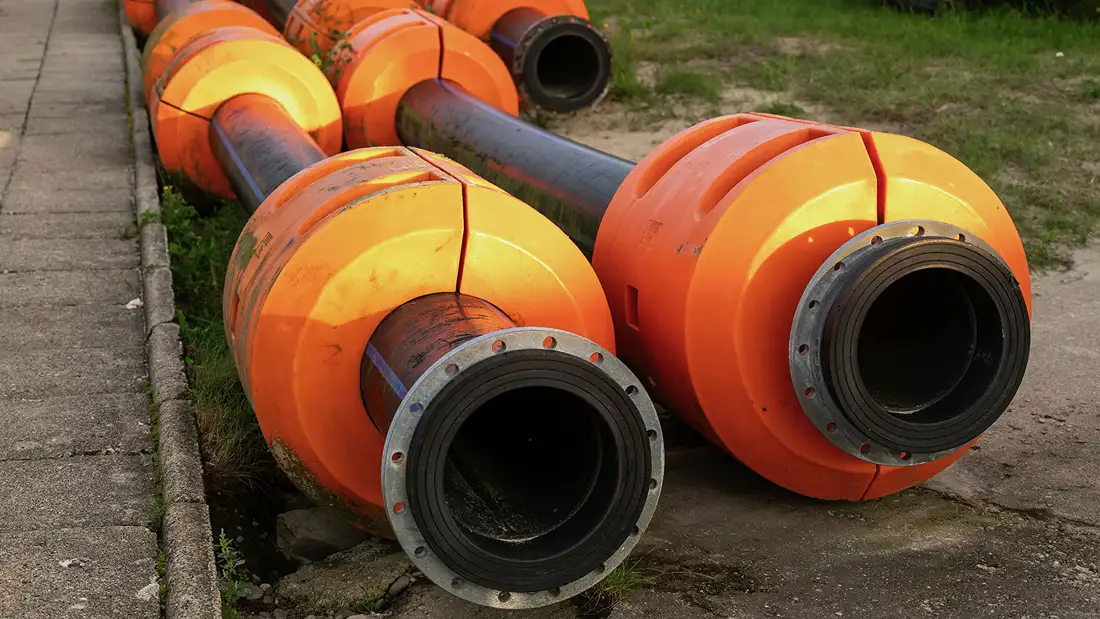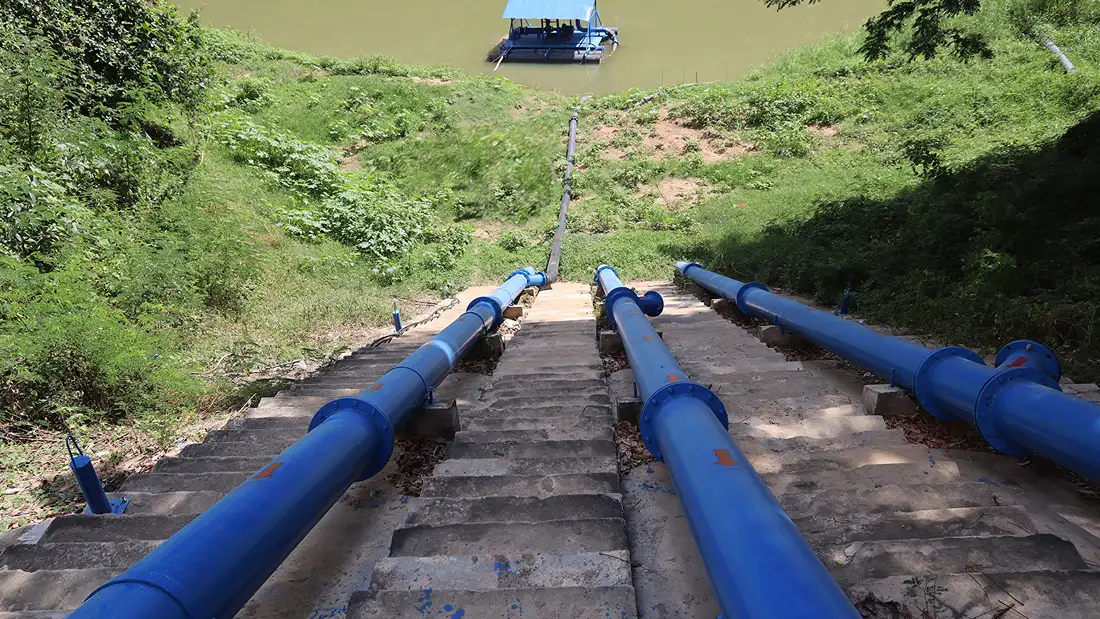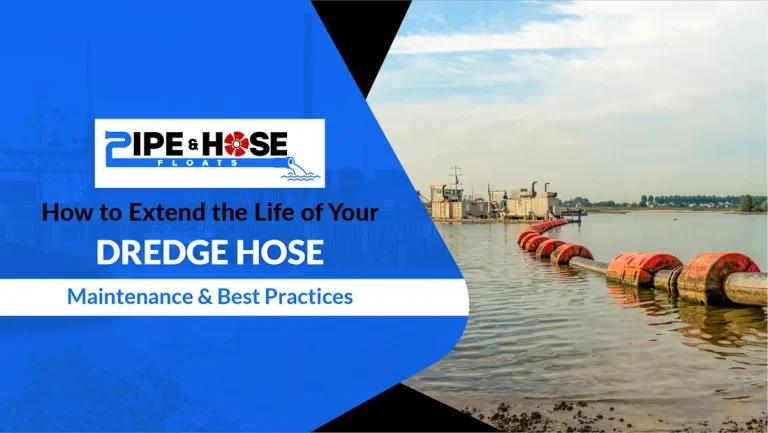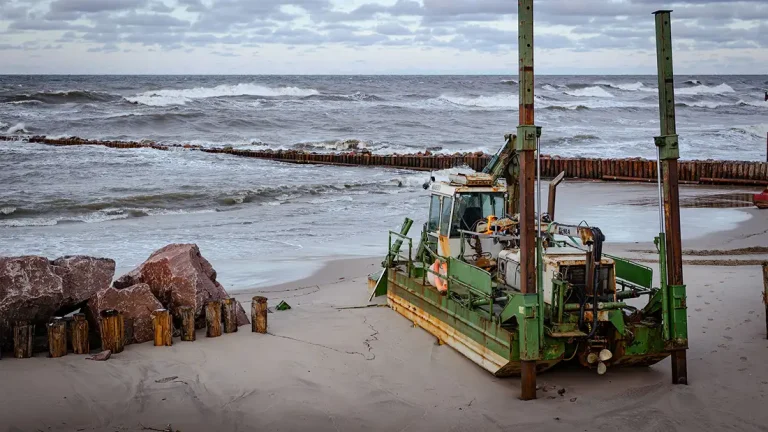Introduction
Floating irrigation pipe solutions are indispensable in various sectors, including agriculture, mining, oil and gas, municipal infrastructure, and defense, where effective water management is crucial. Irrigation pipe floats offer a practical and efficient way to transport water across vast areas, ensuring consistent irrigation for crops, mining operations, and industrial projects. These systems are designed to float on the water’s surface, making them ideal for applications where traditional piping may be difficult to install or maintain. Floating irrigation pipes are particularly valuable for their durability and resistance to environmental factors like UV rays and chemical exposure, ensuring long-term reliability.
The primary benefits of irrigation pipe floats include increased uptime, as the systems remain operational with minimal downtime due to their easy maintenance and durability. These systems also enhance safety by reducing the need for workers to be in hazardous water environments. Moreover, they offer cost-efficiency by reducing installation and maintenance costs, while meeting regulatory compliance standards in various industries. Pipe floats for irrigation contribute to improved water distribution, making them a valuable asset for both large-scale agricultural operations and industrial applications.
Fundamentals of Irrigation Pipe Floats
What Are Irrigation Pipe Floats?
Irrigation pipe floats are specialized flotation devices designed to support and keep irrigation pipes afloat on water surfaces, ensuring stable water distribution for agricultural, industrial, and municipal projects. These floating irrigation pipes are engineered to withstand a variety of environmental conditions while ensuring easy installation and minimal maintenance. Constructed using durable materials like HDPE and reinforced foam, irrigation pipe floats are specifically designed for use in water management systems where traditional piping methods are not feasible. The ability of these pipe floats for irrigation to remain buoyant and flexible makes them an ideal solution for large-scale irrigation systems in both temporary and permanent setups.
Key Functions & Advantages
Irrigation pipe floats serve several critical functions in water distribution systems, offering multiple advantages to industries that depend on a consistent water supply. Their primary function is to support irrigation pipes on the surface of the water, ensuring that water can be transferred across wide areas without risk of blockage or collapse. The key advantages of these floating irrigation pipe systems include:
- Increased Uptime: With robust design features that ensure minimal maintenance, these systems reduce the likelihood of failures, ensuring that irrigation continues even in challenging environments.
- Cost-Efficiency: Pipe floats for irrigation minimize installation and maintenance costs due to their easy setup and low maintenance requirements, which significantly reduce long-term operational costs.
- Safety: These systems provide a safer alternative to traditional piping, particularly in hazardous environments such as flooded areas, tailings ponds, and other unstable grounds, by preventing pipe damage and reducing the need for dangerous manual interventions.
- Regulatory Compliance: By ensuring that irrigation systems adhere to environmental regulations, these solutions help companies stay compliant with water management standards and other local regulations.
Typical Applications
Irrigation pipe floats are widely used across several industries, each benefiting from their versatility and reliability. Typical applications include:
- Agriculture Pivots: Floating irrigation pipes are often used in large-scale agricultural systems, especially in areas where irrigation pivots need to operate across fluctuating water levels. The buoyancy of the pipe floats ensures that water can be delivered evenly and efficiently across fields without the risk of damage or water wastage.
- Tailings Ponds: In mining operations, irrigation pipe floats are used to facilitate water distribution across tailings ponds, ensuring safe and efficient water transfer for environmental and remediation processes. These floats help manage water levels and prevent overflow, reducing environmental risk.
- Emergency Pumping: Floating irrigation pipes are ideal for emergency pumping applications, where temporary water supply systems are needed quickly. Their easy deployment and ability to float on water make them indispensable in flood zones and other disaster-stricken areas.
- Naval Fuel Lines: In military and defense sectors, pipe floats for irrigation are repurposed for naval fuel lines, supporting the delivery of essential supplies over water while ensuring safety and stability during transportation across unstable or fluctuating water bodies.
These diverse applications underscore the flexibility of floating irrigation pipe solutions across critical industries, demonstrating their value in maintaining operational efficiency and safety.
Design Principles for Floating Irrigation Pipe Systems
Buoyancy & Stability Basics — Displacement, Center-of-Gravity, Freeboard Targets
The design of floating irrigation pipe systems is centered around maintaining buoyancy and stability, ensuring the pipes remain securely afloat in varying water conditions. Displacement refers to the volume of water that a floating pipe system pushes out of the way, which directly correlates to its buoyancy. To achieve optimal performance, the float must displace a volume of water equal to or greater than the weight of the pipe system, including the water it carries, fittings, and other components.
Center of gravity is another critical design element. The system’s center of gravity should be kept low to prevent tipping and maintain balance. A low center of gravity ensures that the floating pipe system remains stable and minimizes the risk of rolling or instability in turbulent water conditions. Additionally, freeboard targets are set to ensure there is enough pipe above the water surface, providing sufficient clearance for handling, maintenance, and preventing submersion under fluctuating water levels. Properly calculated displacement, center-of-gravity, and freeboard work together to ensure the system’s reliability and performance under various operational conditions.
Environmental Load Factors — Waves, Currents, Wind, Debris Impact
Floating irrigation pipe floats must be designed to withstand a variety of environmental load factors, including waves, currents, wind, and debris impact. Waves and currents can exert significant forces on the pipes, especially in open water bodies or areas prone to tidal movements. The design of the irrigation pipe floats system must account for these forces, ensuring the system stays anchored and stable.
Wind is another factor that must be considered, as strong gusts can push irrigation pipe floats off-course, causing them to shift or become displaced. To mitigate this, the pipes may be equipped with additional anchoring or tethering systems to ensure they remain in position.
Debris impact also poses a challenge, especially in agricultural and industrial settings where irrigation pipe floats may encounter floating plant material, waste, or large objects. The system should be designed with impact-resistant materials or protective covers that prevent damage to both the pipes and the flotation devices, ensuring long-term durability.
Addressing these environmental factors ensures the irrigation pipe floats system operates smoothly in unpredictable conditions, without drifting, preventing damage, and maintaining operational continuity.
Hardware Interfaces — Clamps, Straps, Flanges, Quick-Release Couplings
The efficient installation and maintenance of floating irrigation pipe systems rely heavily on robust hardware interfaces, which allow for secure connections between pipes, floats, and other system components. Clamps are essential for fastening pipes securely to the floats, ensuring stability and preventing movement or disconnection during operation. These clamps must be made of corrosion-resistant materials to withstand the elements and ensure long-term performance.
Straps are often used to provide additional support, particularly for larger systems or pipes in high-flow environments. These straps help distribute the load evenly across the floatation devices, ensuring the pipes remain buoyant and aligned correctly.
Flanges are critical for joining pipes together and facilitating easy assembly and disassembly. The flange design should ensure a tight seal to prevent leaks and maintain the integrity of the irrigation system. These connections must also allow for ease of repair or maintenance when needed.
Quick-release couplings are increasingly utilized in floating irrigation systems, especially for temporary or emergency water transfer needs. These couplings allow for quick detachment and reattachment of sections of the irrigation pipe system, which is especially valuable in changing conditions or when the system needs to be relocated. Together, these hardware interfaces ensure the floating irrigation pipes are easy to install, maintain, and operate, with minimal downtime and maximum flexibility.
Load Capacity Assessment
Calculating Supported Weight — Pipe + Water + Fittings + Safety Allowance
Accurately calculating the supported weight of a floating irrigation pipe system is crucial for ensuring the system’s stability and functionality. The total weight that the irrigation pipe floats must support consists of several components:
- Pipe Weight: The weight of the irrigation pipe itself varies depending on the material used (e.g., PVC, HDPE, or steel). This can be calculated using the pipe’s dimensions and material density. For example, a 6-inch HDPE pipe has a specific weight per meter, which is then multiplied by the total length of the pipe used in the system.
- Water Weight: The weight of the water inside the irrigation pipe needs to be considered, as it significantly contributes to the load. Water weighs approximately 1 kg per liter (1 kg/L), so the weight of water in the pipe can be calculated by multiplying the pipe’s internal volume (determined by its diameter and length) by 1 kg/L.
- Fittings and Accessories: Additional components such as pipe connectors, valves, couplings, and elbows all contribute to the total load. The weight of these components is typically provided by manufacturers and should be added to the overall calculation.
- Safety Allowance: A safety margin is added to account for unforeseen stresses, such as environmental factors or slight miscalculations in the other weight elements. A common safety allowance is between 10% to 25% of the total calculated weight, depending on the operating environment and potential risks. This ensures the system remains stable and functional under various load conditions.
By summing the weight of the pipe, water, fittings, and safety allowance, the total weight that the irrigation pipe floats must support is obtained, ensuring the system remains stable and operational under expected conditions.
Recommended Safety Factors & Codes
To ensure the long-term reliability and safety of floating irrigation pipe systems, industry-standard safety factors and codes are essential for design and construction. Safety factors are a measure of the additional load-bearing capacity built into a system to ensure that it can withstand unexpected stresses without failure. The safety factor accounts for potential overloading, environmental factors, and material degradation over time. Typically, a safety factor of 1.5 to 2 times the calculated load capacity is recommended for irrigation pipe floats, depending on the risk level and environmental conditions.
By adhering to these safety factors and codes, the system is better equipped to handle unforeseen stresses and extend the longevity of the pipe floats for irrigation.
Material Selection for Pipe Floats
Comparative Matrix — HDPE, RPE, PU-Coated Foam, Steel, Composites
When selecting materials for irrigation pipe floats, it is crucial to evaluate each material’s performance, durability, and cost-effectiveness in relation to the specific application. Below is a comparative matrix of commonly used materials for pipe floats in irrigation systems:
| Material | Key Features | Typical Use | Pros | Cons |
| HDPE (High-Density Polyethylene) | Lightweight, corrosion-resistant, UV-stable, durable under pressure | Agricultural irrigation systems, coastal applications | UV-resistant, high impact strength, excellent chemical resistance | Can become brittle in extreme temperatures |
| RPE (Reinforced Polyethylene) | Flexible, tear-resistant, excellent UV stability, chemical resistance | Canal lining, water storage, and irrigation pipe floats | Long lifespan, strong against punctures and tears | Can be more expensive than standard polyethylene |
| PU-Coated Foam (Polyurethane-coated foam) | High buoyancy, good thermal insulation properties, flexible | Floating irrigation pipes, flood control applications | High buoyancy, resistance to water penetration | Potential for surface wear over time, higher cost |
| Steel | High strength, durable, pressure-resistant | Industrial and emergency irrigation systems | High strength, can support larger loads | Prone to corrosion, heavier, and more expensive |
| Composites | A combination of materials, such as fiberglass and plastic, for enhanced performance | Heavy-duty, high-load applications, specialized uses | Superior strength-to-weight ratio, durable under harsh conditions | Expensive, not as flexible as HDPE or foam-based options |
The choice of material depends on factors such as load-bearing requirements, environmental conditions (e.g., UV exposure, temperature), and budget constraints. For most irrigation applications, HDPE and PU-coated foam offer the best combination of durability, cost-effectiveness, and ease of installation.
Foam-Filled vs Hollow-Chamber Designs
Two common designs for irrigation pipe floats are foam-filled and hollow-chamber designs. Each offers distinct benefits and drawbacks depending on the specific requirements of the irrigation system.
- Foam-Filled Designs:
Foam-filled floats use a solid core of polyurethane or similar material to provide buoyancy. These designs offer the benefit of high buoyancy with no risk of internal air loss, even if the outer casing is punctured. Foam-filled floats are often used in high-stress applications, where constant buoyancy is critical. They are highly resistant to water penetration and are commonly used in agricultural irrigation systems and emergency flood control projects.- Pros: High buoyancy, durable, resistant to punctures, and long-lasting.
- Cons: Typically more expensive than hollow-chamber options, heavier than hollow-chamber floats.
- Hollow-Chamber Designs:
Hollow-chamber floats feature a closed cavity of air, typically enclosed in a durable outer material, providing buoyancy. These floats are lighter and less expensive to produce compared to foam-filled designs. However, they may be more vulnerable to punctures and air leakage over time, which can compromise buoyancy. Hollow-chamber designs are best suited for temporary or low-load applications where cost and weight are primary concerns.- Pros: Lightweight, cost-effective, easy to transport, and handle.
- Cons: Susceptible to punctures or damage from rough conditions, lower buoyancy capacity under heavy loads.
The choice between foam-filled and hollow-chamber designs depends on the intended use, environmental conditions, and load requirements of the irrigation system.
UV, Chemical & Abrasion Resistance Considerations
Irrigation pipe floats are frequently exposed to harsh environmental conditions, such as UV radiation, chemicals, and abrasive materials. The material used in the floats must be resistant to these elements to ensure long-term durability and performance.
- UV Resistance:
UV degradation can cause materials like PVC and polyethylene to become brittle and weaken over time. HDPE and RPE are naturally UV-resistant, while foam materials typically require a UV-resistant coating or laminate to prevent breakdown from prolonged sun exposure. UV-resistant coatings are essential for irrigation pipe floats used in outdoor applications, where exposure to direct sunlight is frequent. - Chemical Resistance:
Irrigation systems often involve exposure to chemicals, including fertilizers, pesticides, and soil additives. HDPE and RPE are resistant to most agricultural chemicals, making them ideal for use in irrigation systems. PU-coated foam offers strong chemical resistance as well, but steel and other metals can corrode when exposed to harsh chemicals, reducing their lifespan. - Abrasion Resistance:
Floating irrigation pipes are susceptible to abrasion, particularly when used in environments with high water flow or debris. Composites and PU-coated foam are known for their superior abrasion resistance, making them ideal for rougher environments. Steel is also highly resistant to wear, but it is heavier and may require additional maintenance to prevent rusting.
Sustainability & Recyclability
With increasing environmental awareness, the sustainability and recyclability of materials used in irrigation pipe floats have become more important. Materials such as HDPE and RPE are both recyclable and offer long service life, reducing the need for replacement and minimizing waste. HDPE, in particular, is one of the most widely recycled plastics, making it a highly sustainable option for floating irrigation pipes.
Composites, though durable, may not be as easily recyclable depending on the specific materials used in the construction. PU-coated foam, while durable and long-lasting, may be more challenging to recycle due to its material composition.
To improve sustainability, manufacturers are increasingly developing new materials and designs that combine durability with recyclability. As demand for eco-friendly solutions grows, the use of sustainable materials like HDPE and RPE in pipe floats for irrigation will continue to be a priority for both manufacturers and consumers.
Choosing sustainable and recyclable materials for irrigation pipe floats contributes to long-term environmental benefits by reducing waste, conserving resources, and ensuring that systems remain operational with minimal ecological impact.
Ensuring Efficiency and Reliability in Floating Irrigation Pipe Systems
In summary, designing and selecting the right irrigation pipe floats involves careful consideration of key factors such as buoyancy rating, load capacity, materials, and compatibility with existing infrastructure. The performance of floating irrigation pipes depends on the materials used (e.g., HDPE, PU-coated foam, RPE, and steel), each offering distinct advantages depending on environmental conditions, load requirements, and project duration. Understanding how to assess load capacity, calculate buoyancy, and select the appropriate materials ensures the system remains operational, safe, and cost-effective over its lifespan.
By adhering to performance metrics, regulatory standards, and engineering best practices, you can ensure that the irrigation pipe float system operates efficiently and reliably across various applications, from agricultural pivots to mining and emergency pumping systems. Investing in quality, durable pipe floats and implementing routine maintenance practices can deliver significant long-term cost savings, enhanced safety, and optimized system performance.
For a tailored solution that meets your specific needs, we invite you to consult Pipeandhosefloats.com for project-specific engineering support. Our team of experts can assist you in selecting the best floating irrigation pipe system for your unique requirements, ensuring optimal performance and value.


